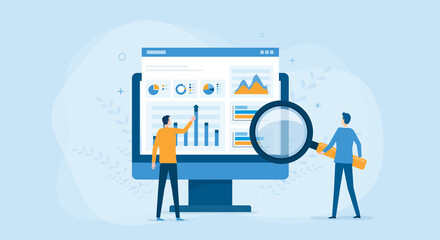Introduction
Imagine taking a long road trip without a dashboard—no speedometer, no fuel gauge, and no navigation system. It would be a risky venture, leaving you blind to critical information about your vehicle’s performance. Now, consider your business: many organizations today are inundated with data yet lack the meaningful insights required to steer them towards success. In this post, we will explore the concept of KPI (Key Performance Indicator) dashboards, uncovering their significance in today’s data-driven landscape. We’ll delve into how these powerful tools can transform raw data into actionable insights and provide a step-by-step guide to implementing an effective KPI dashboard tailored to your business’s unique needs.
What Is a KPI Dashboard?
A KPI dashboard serves as a dynamic visual representation of key performance indicators that illustrate the overall health and efficiency of your business in real time. By leveraging advanced tools such as Power BI, Tableau, Excel, or Looker Studio, these dashboards can be designed to provide critical insights into various aspects of your operations. They allow stakeholders to monitor performance trends, identify areas for improvement, and make informed decisions quickly and with minimal effort. With the ability to display data visually, KPI dashboards transform complex information into easily digestible formats, enabling teams to stay agile and responsive to changing business conditions.
Why KPIs Matter for Business Leaders
- Assists in monitoring progress toward specific business objectives, providing clear insights into how effectively goals are being met over time.
- Detects emerging trends early on, whether favorable or unfavorable, allowing organizations to respond proactively rather than reactively.
- Facilitates data-driven decision-making, ensuring that choices are based on solid evidence rather than intuition alone.
- Fosters collaboration among teams by aligning them around common metrics, creating a unified focus that drives collective success.
What Makes a Good Dashboard?
- Focused: Streamlined and uncluttered, the presentation highlights only the most important information, ensuring clarity and relevance.
- Real-time: Continuously updated, providing the latest data and insights instantly to keep everyone informed and engaged.
- Actionable: Designed to guide users towards the next steps effectively, empowering them to make informed decisions and take prompt action.
- Tailored: Customized views cater to the specific needs of different teams, including executives, sales, operations, and more, ensuring that everyone has the information that matters most to them.
What to Include in a KPI Dashboard
Here are detailed examples categorized by function:
- Sales: Key performance metrics include monthly revenue, which measures the total sales generated within a month; pipeline coverage, reflecting the ratio of qualified leads to sales targets; and win rate, indicating the percentage of sales opportunities that result in successful deals.
- Marketing: Important metrics consist of Customer Acquisition Cost (CAC), which calculates the total cost of acquiring a new customer; conversion rate, showcasing the effectiveness of marketing efforts in turning leads into customers; and web traffic, which tracks the number of visitors to a website, highlighting overall audience engagement.
- Finance: Critical financial indicators include burn rate, measuring the rate at which a company is spending its cash reserves; runway, which estimates the amount of time a business can operate before needing additional funds; and operating margin, reflecting the percentage of revenue that remains after covering operational costs.
- Operations: Essential metrics include utilization, indicating the extent to which available resources or personnel are being utilized effectively; and delivery time, which tracks the duration it takes from order placement to delivery, impacting customer satisfaction.
- Customer Success: Key indicators include Net Promoter Score (NPS), a gauge of customer loyalty and satisfaction; churn rate, which measures the percentage of customers lost over a specific period; and Customer Satisfaction Score (CSAT), providing insights into customers’ overall satisfaction with the products or services offered.
Real-World Example
Before we integrated dashboards into our reporting process, our reports lagged significantly, often arriving two weeks late. This delay hindered our ability to make timely decisions. Now, with dashboards in place, we have the capability to make informed choices in real time. For instance, one of our clients experienced a remarkable 45% increase in forecasting accuracy during the first quarter after adopting this system. This transformation has not only streamlined our operations but also empowered our clients to react swiftly and effectively to market changes.
How to Get Started
- Identify Your Top 5–7 Key Metrics: Begin by determining the most critical indicators of success for your organization. These metrics should align with your strategic objectives and provide insights into performance, trends, and areas for improvement. Focus on those that are actionable and can drive decision-making.
- Choose a Dashboard Tool Your Team Can Use: Select a user-friendly dashboard tool that suits your team’s needs and capabilities. Consider options that allow for easy integration with existing data sources, offer customizable visualizations, and provide real-time updates, ensuring that everyone can effectively monitor performance at a glance.
- Start with a Prototype Using Real Data: Create a preliminary version of your dashboard using actual data to test your key metrics. This prototype will help you visualize how the metrics interact and will allow for adjustments based on feedback before rolling out a final version.
- Consider a Data Partner to Accelerate Implementation: Engage with a specialized data partner who can bring expertise and resources to your project. This partnership can streamline the implementation process, provide additional insights, and enhance the overall functionality of your dashboard, ultimately saving time and optimizing results.
Want Help?
We specialize in assisting small and medium-sized businesses (SMBs) in creating personalized KPI dashboards that truly empower decision-making. Our Dashboard Starter Kit provides an intuitive and user-friendly way to visualize your key performance indicators, making it easier to track progress and make informed choices. Reach out to us to learn more about this innovative tool or schedule a complimentary consultation today at Fuzzitech
#KPIs #DataDriven #SMBGrowth #BusinessIntelligence #PowerBI #Tableau #DataAnalytics



